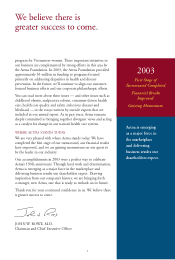Aetna 2003 Annual Report Download - page 21
Download and view the complete annual report
Please find page 21 of the 2003 Aetna annual report below. You can navigate through the pages in the report by either clicking on the pages listed below, or by using the keyword search tool below to find specific information within the annual report.
19
injury out of common law
courts and into an administrative
system adjudication or
arbitration proceeding. Just as
important would be to drop
the requirement for proof of
negligence and endorse
avoidability as the critical criteria
for payment, likely leading to
more compensation for injured
individuals, the costs of which
would be covered by decreased
administrative costs (particularly
lawyers’ fees). Both of these
moves will harmonize
compensation with notions
of blame-free reporting of
events and concerted efforts
to learn from, rather than hide,
the errors that cause injury.
Only in this fashion will we see
just compensation for injury
and development of an attitude
of safety improvement in
American medicine.
In 2004, the United States health care system enters the third
year of a deepening malpractice crisis. Across the country,
physicians are experiencing another round of double-digit
increases in their medical malpractice insurance premiums.
Fueled by ever-higher median
awards to successful litigants,
and increasingly by greater
frequency of lawsuits, the crisis
shows no signs of abating.
There is also evidence that
the burden of the costs of
malpractice is changing
physician practice, in particular
that it is leading to problems
with access as physicians
retire early, move to less
litigious states or limit care
in a variety of ways.
The tragedy about the
malpractice crisis is that tort
litigation based on medical
injuries has failed to fulfill its
two critical societal functions:
compensation for those injured
by negligent behavior and
deterrence of such behavior.
Studies have shown that
malpractice performs very
poorly as a compensation
device: It is inaccurate in
that many people who are
not injured by negligence
are compensated; most of
those injured do not receive
compensation; and its
administrative costs are
enormous. Moreover, there is
no evidence that malpractice
provides any significant
deterrence of substandard care.
In fact, most experts believe that
malpractice litigation frustrates
efforts to institute the sort of
blame-free environment upon
which a culture of safety in
health care depends.
What should be done?
Unfortunately, most reformers
today are interested only in
conventional tort reform, that
is efforts to decrease the number
of suits brought by plaintiffs’
attorneys, usually by reducing
the award to the successful
litigant, and hence the
reimbursement for the attorney
who relies on a contingency fee.
Reforms such as caps on awards
also unfairly penalize severely
injured patients. Perhaps more
important, they do nothing to
address the fundamental defects
of the tort system, in particular
as a method to promote safety.
More sensible, if more sweeping,
reform would be to get decisions
about compensation for medical
Medical Malpractice Reform
There is evidence
that the burden of the
costs of malpractice
is changing
physician practice.
























